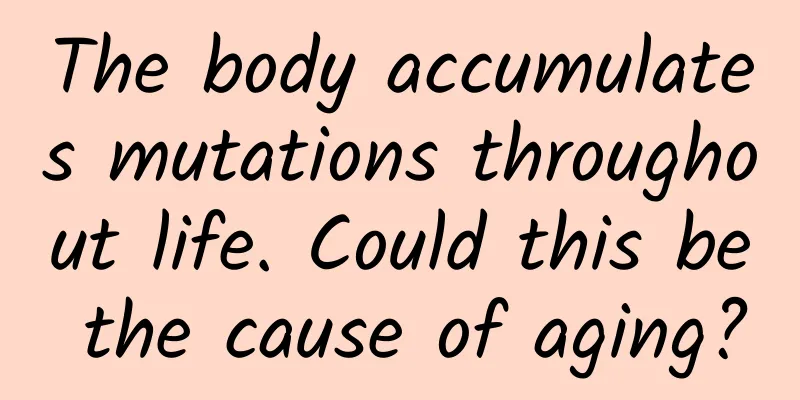The body accumulates mutations throughout life. Could this be the cause of aging?

|
Imagine your body, a mosaic of cells with thousands of genetic mutations that accumulate over a lifetime. Many are harmless, some are harmful, and some may be good for you. Written by Amber Dance Translation | XZ Source | Knowable Magazine When people reach middle age, they become a complex mosaic of cells, most of which are identical but not completely identical. 丨 Image source: Knowable Magazine When the sperm and egg meet to form a fertilized egg, life begins from this moment; thereafter, the fertilized egg, which incorporates the genes of both parents, undergoes gene replication and cell division, slowly forming the current "you". However, "danger" also quietly arrives at this moment, that is, errors that occur during the gene replication process begin to accumulate. “This process of errors accumulating in the genome continues throughout your life,” says Phil H. Jones, a cancer biologist at the Wellcome Sanger Institute in the United Kingdom. Scientists have long known that the gene replication system occasionally goes wrong - cancer often arises in this way, but due to the technical limitations of the time, people did not know which gene abnormalities were strongly associated with cancer. Until the past few years, as gene sequencing technology has gradually matured, this "veil" has slowly been lifted - our bodies are full of errors. Each person is a giant "mosaic" made of cells, most of which are the same, but the details are different. In theory, the genes of all cells in the human body come from the same set of genes, so they should be identical, but this is not the case. The genomes of cells may differ by only one "genetic letter" at one location, while missing a larger chromosome fragment at another location. Michael Lodato, a molecular biologist at the University of Massachusetts Medical School, estimates that by middle age, each cell may have about a thousand genetic errors. Even if cells’ DNA replication machinery is extremely accurate and cells have excellent repair mechanisms, these mutations—whether in the blood, skin, or brain—can still accumulate. An adult’s body contains about 30 trillion cells, and about 4 million of them divide every second, so over time, even genes with a very low error rate have a risk of errors accumulating. (Errors are far fewer in cells that produce eggs and sperm; the body seems to expend more energy preventing mutations in reproductive tissues so that pristine DNA can be passed on to future generations.) "It's a small miracle that we're all living normal lives," Jones said. The presence of cells with mutations in a tissue does not necessarily mean that they will cause disease. Mutations that promote cell cloning can be dangerous carcinogenic factors, but they can also be neutral or even beneficial. These mutations can maintain the integrity of the tissue and will not promote cancer. 丨Image source: A. Herms & PH Jones /AR CANCER BIOLOGY 2023, Knowable Magazine Scientists are still in the early stages of investigating the causes and consequences of these mutations. The National Institutes of Health is investing $140 million to catalog these genes, and the National Institute of Mental Health has invested tens of millions of dollars in studying brain mutations. While most mutations are harmless, some have effects on cancer and neurological diseases; some researchers even suspect that random genomic errors that occur throughout life may be a major cause of the aging process. “We’ve known about these things for less than a decade, and it feels like we’ve discovered a whole new world,” Jones said. “We haven’t even scratched the surface of what they can do.” Full of doubts from the beginning Since the discovery of DNA's structure in the 1950s, scientists have suspected that genetic mutations that accumulate in non-reproductive, or somatic, tissues might help explain disease and aging. It wasn't until the 1970s that researchers learned that growth-promoting mutations in a small fraction of cells are the origin of cancer. “The assumption was that this event happens very, very rarely,” says Jan Vijg, a geneticist at the Albert Einstein College of Medicine in Boston, Massachusetts. However, it was very difficult to detect and study such mutations at the time. Conventional DNA sequencing extracted genetic material from a large number of cells and could only reveal the most common gene mutations, while some rare gene mutations could not be detected. Siddhartha Jaiswal, a stem cell biologist at Stanford University, said that this situation began to change around 2008. New technologies are very sensitive and can detect mutations in a very small number of cells (or even a single cell). In the early 2010s, Jaiswal became interested in how mutations accumulate in human blood cells and lead to blood cancer. He and his colleagues found the following pattern in blood samples from more than 17,000 people: cancer-related mutations are rare in people under 40, but their number increases with age; especially after the age of 70, blood cells carry mutations, accounting for 10% or more**[1]**. In addition, the team also found that cells with mutations are often genetically identical and are clones. Jaiswal believes that this may be because one of the thousands of hematopoietic stem cells in the human body has mutated, making it more capable of growth and division; decades later, these mutated cells begin to eliminate normal stem cells, resulting in a large number of mutant clones. Unsurprisingly, the accumulation of these mutant cells is closely linked to the emergence of blood cancers; they are also associated with an increased risk of heart disease, stroke, and death from any cause, possibly because they promote inflammation. But surprisingly, such patients have a one-third lower risk of developing Alzheimer’s disease**[2] . Jaiswal, who co-authored a 2023 article in the Annals of Medicine on the health effects of blood cell clones, speculates that these clones may be better at populating brain tissue or clearing toxic proteins [13]**. As Jaiswal and colleagues were advancing their 2014 study of mutations in blood cells, researchers at the Wellcome Sanger Institute began looking at mutations in other tissues, starting with the skin around the eyes. As some people age, their eyelids droop, requiring surgery to remove some skin to repair them. The researchers obtained skin tissue from four people and cut out circular sections 1 to 2 millimeters in diameter for genetic sequencing. “The results were astonishing,” says Inigo Martincorena, a geneticist at the Wellcome Sanger Institute. Although these patients did not have skin cancer, their skin was riddled with thousands of mutated cells, and between one-fifth and one-third of these cells contained mutations associated with cancer.[4] The discovery that skin cells from people without skin cancer had so many mutations caused a stir. "I was blown away," says James DeGregori, a cancer biologist at the University of Colorado Anschutz Medical Campus. Subsequently, researchers have found the same population of mutant cells in tissues including the esophagus[5], bladder[6] and colon. For example, colonic crypts are tiny depressions on the surface of the colonic mucosa that are an important part of the intestinal absorption and secretion functions; each person has about 10 million of these crypts, each containing about 2,000 cells, all of which are generated by a small number of stem cells in the crypt. In a study of more than 2,000 crypts in 42 people, researchers found hundreds of variants in the crypt genes of people in their 50s[7]. In this age group, about 1% of normal crypts contain cancer-associated mutations, some of which can inhibit the proliferation of nearby cells[8], allowing mutant cells to occupy crypts more quickly[9]. This alone is not enough to cause colorectal cancer, but in rare cases, cells can acquire additional oncogenic mutations, overflowing the crypt boundaries and leading to the formation of malignant tumors. The colon contains many crypts or recessed structures, each filled with cells. These structures make the colon an ideal place to study the evolution of mutant clones. 丨 Image source: Josluis /stock.adobe.com “Cellular mutations seem to exist in every organ, treating the body as a kind of evolutionary battlefield,” Jones said. As cells accumulate mutations, their ability to grow and divide may increase (or decrease). Over time, some cells with better reproductive ability replace others, forming large clones. However, DeGregori points out that “even though we have mutations everywhere, our bodies are not in chaos.” He believes that our tissues must have some mechanism to prevent clones from developing into cancer cells, and not all mutant cells that continue to divide and form cell groups will form malignant tumors. As Jones and a co-author described in the 2023 Annual Review of Cancer Biology, in mice, overproliferating mutant clones returned to normal growth [10]. Jones and his colleagues have also found an example of the body's self-protection in the human esophagus. In middle age, many esophageal cell clones (colonies of cells that form from a single stem cell through normal cell division) develop mutations that disrupt a gene called NOTCH1.[11] This does not affect the esophagus's ability to move food, but cancers appear to require NOTCH1 to grow. Although harmful mutations may accumulate in esophageal cells, these mutant cells appear less likely to become tumors if NOTCH1 is missing. In other words, there are good, bad, or neutral mutations. Fortunately, the good or neutral mutations tend to prevail. As people age, the size of mutation clones increases. Each square represents one square centimeter of esophageal tissue in the subject. The youngest subject (above) was a moderate smoker; the other two were non-smokers. The size and color of each circle represents a clone carrying a specific gene mutation. Sometimes, a clone contains multiple mutations, meaning the circles overlap. Mutations in some genes, such as TP53 (orange), promote cancer, while mutations in other genes, such as NOTCH1 (purple), suppress cancer. Image source: I.Matrincorena Et al/Science2018, Knowable Magazine The brain is not immune Because cells in the esophagus, colon and blood are constantly dividing, there is always the risk of errors in DNA replication. But neurons in the brain stop dividing before or soon after birth, so scientists initially thought they would remain genetically primitive, says Christopher Walsh, a neurogeneticist at Boston Children's Hospital. However, studies have shown that mutations accumulated throughout life may cause problems in the brain. As early as 2004, researchers reported that a patient with Alzheimer’s disease had mutations in some cells in his brain[12]. These mutations were new and not inherited from either parent. This suggests that cells in the brain can also mutate, Lodato said. Mutations may occur early in development, before the brain is fully developed and cells stop dividing, or in mature brain cells, DNA may be damaged and cannot be repaired normally, resulting in mutations. By 2012, research into non-inherited brain mutations (also called somatic mutations) was gaining momentum. Thomas Insel, then director of the National Institute of Mental Health, proposed that such mutations might underlie many mental illnesses.[13] This could explain a long-standing puzzle in neurological disorders: why identical twins typically do not share the same mental illness (for example, if one twin has schizophrenia, the other has only about a 50% chance of developing the same disease). “Mosaicism provides a very compelling answer,” says neuroscientist Mike McConnell, who is currently the scientific director of the Lennox-Gastaut Syndrome Foundation, a nonprofit that supports families and researches severe forms of epilepsy. Starting in the early 2010s, McConnell, Walsh, Lodato, and others began cataloguing mutations, big and small, in the brains of deceased people. They counted deletions and duplications of single genes, multiple genes, or entire chromosomes[14] , and found entire chromosomal segments of the genome that had moved to new locations. In a sample of the brain of a 50-year-old deceased person, they found 1,000 or more single-base mutations in the genetic code of each of his neurons [15]. The discovery, Walsh recalls, “seemed completely impossible to us. We doubted ourselves.” Faced with such a striking result, the researchers conducted further investigation. By observing 159 neurons from 15 people who died between the ages of 4 months and 82, they found that the number of mutations increased with age, suggesting that errors accumulate over time[16], and that the brain, like other parts of the body, "is a deep mosaic." To further explore this mosaicism, the National Institute of Mental Health funded a series of projects from 2015 to 2019, with samples mostly collected from more than 1,000 neurotypical people or people with conditions such as Tourette syndrome and autism spectrum disorder. Single-letter mutations are the most common, said McConnell, who co-led the project. The researchers have amassed more than 400 terabytes of DNA sequences and other data and developed analytical tools, creating a powerful platform that will lay the foundation for the next round of brain mosaicism research. Through this work and other studies, scientists have linked brain mosaicism to neurological diseases including autism, epilepsy and schizophrenia. In Lodato's lab, graduate students Cesar Bautista Sotelo and Sushmita Nayak are studying how accumulated mutations lead to amyotrophic lateral sclerosis (ALS, also known as Lou Gehrig's disease). Geneticists have been able to identify known mutations in only about 10% of non-inherited cases,[17] but new data on mosaicism suggest that many more people may have ALS gene mutations in their brain or spinal cord even if they do not have them elsewhere in their bodies. This is important because scientists are working on gene therapies for ALS,[18] a disease involving more than 40 genes that, when mutated, cause ALS. In 2023, the U.S. Food and Drug Administration (FDA) approved the first such treatment, which turns off a common mutated ALS gene. So for patients to receive this treatment, they need to know their mutation. Therefore, Nayak says, “we strongly advocate for a change in the current practice of diagnosing ALS.” In addition to examining DNA in blood samples, other tissues, such as saliva, hair or skin, should be examined for ALS gene mutations in case the mutations arise during development in cells that don’t produce blood but are involved in other physiological processes. Clues to aging Right now, the health implications of mosaicism are mostly too vague, especially in cases like blood cell clones. “We’re not really advocating that people worry about it,” Jaiswal said. “At this stage, there’s no reason to test healthy people.” But many scientists believe that these findings provide evidence for a long-standing theory: that mutations that occur throughout life may be associated with aging**[19]**. Martincorena and colleagues tested this theory in a 2022 study. They argued that if the accumulation of mutations causes aging, then short-lived animals like mice should accumulate mutations more quickly, while long-lived species like humans should accumulate mutations more slowly, perhaps because we have better repair mechanisms. To investigate this idea, the researchers embarked on a five-year quest. They studied colon crypt samples from eight humans and animals, including 19 rats and mice; 15 domestic animals, including cats, dogs, cows, rabbits, etc.; and 14 other species, including tigers, lemurs, dolphins, and naked mole rats, the latter of which is known for its extremely long lifespan of more than 30 years. As predicted, the longer the lifespan of a species, the lower its mutation rate[20]. The researchers analyzed colon crypts from a variety of animals and found that species with longer lifespans, such as humans, had lower mutation rates, while species with shorter lifespans, such as mice, had higher mutation rates, which is consistent with a long-standing theory that somatic mutations are associated with aging. Image source: A. Cagan et al/Nature 2022, Knowable Magazine "This doesn't show that somatic mutations cause aging, but the possibility that they at least play a role is consistent with theory," Martincorena said. Two factors are at work here: Accumulated mutations lead to a shorter lifespan, but a shortened lifespan makes mutation protection less critical, so species with shorter lifespans invest less in DNA repair. The idea that mutations might cause aging is tantalizing, because it suggests that if you could eliminate them, you might have found the fountain of youth. "If I found a way to stop these mutations from accumulating tomorrow, I think I'd be a super-rich man," Bautista Sotelo says. At least one biotech startup, Matter Bio in New York City, has raised funding to repair the human genome. But whether such a plan could work in a wide range of cells is another matter. "I don't think you can completely eliminate these mutations," DeGregori says. The mutation story is far from over. “Based on the discoveries we have made so far, the journey has just begun,” Martincorena said. “I expect there will be many surprises in the next few years.” Note: The cover image of this article comes from the copyright library. Reprinting and using it may cause copyright disputes.
1. Go to the "Featured Column" at the bottom of the menu of the "Fanpu" WeChat public account to read a series of popular science articles on different topics. 2. Fanpu provides a function to search articles by month. Follow the official account and reply with the four-digit year + month, such as "1903", to get the article index for March 2019, and so on. Copyright statement: Personal forwarding is welcome. Any form of media or organization is not allowed to reprint or excerpt without authorization. For reprint authorization, please contact the backstage of the "Fanpu" WeChat public account. |
<<: Infinite Monkey Theorem: Monkeys, Typewriters, and the Secret of the Universe
Recommend
Practical! Keep this guide to avoid scams during the May Day holiday
Have you ever encountered the traps of holiday tr...
Are marketing and operations unclear? Let's take a look at their essential differences and 5 major inspirations
The ambiguous relationship between marketing and ...
This kind of beans is perfect to eat in spring, but some people should eat it with caution
Ruan Guangfeng Broad beans are a kind of legumes ...
Is the jade rabbit on the moon the rabbit from Spicy Rabbit Head?
Legend has it that there is a jade rabbit living ...
Looking at the breakthrough and growth logic of enterprise service products from the perspective of WeChat for Business!
Whenever Tencent releases a new product, the enti...
How can a novice do a good job in business promotion?
Judging from the current situation, the main prob...
Musk becomes the world's richest man, is the secret the "first principles"?
Musk is the richest man in the world, and he owns...
Tencent: US ban on WeChat may not apply to apps in China
According to previous regulations of the US gover...
How to plan a marketing campaign that can create multiple values?
The World Cup craze has just passed, and problems...
Is the high-priced "baby water" really healthy or a "tax on IQ"? The secret is revealed for you →
Those who have children at home may find that the...
Apple releases new patent? Can it solve the crease problem of foldable devices?
According to foreign media reports, the U.S. Pate...
When will the Shanghai epidemic end in 2022 and return to normal? Can it be completely over before May 1st? Attached is the latest official news
Recently, the number of new local cases reported ...
Which categories can take advantage of Xiaohongshu's marketing to break through the circle on "International Women's Day"?
After the charity live broadcast ended last week,...
The 50 most popular street vendors in coastal rural towns
The 50 most popular street stall businesses in co...
Are there other planets that support life outside of Earth? Current research has found that…
The universe, this vast and mysterious realm, has...









